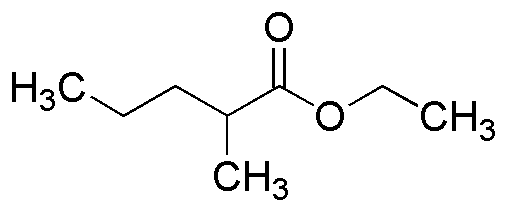Ethyl 2-methylpentanoate is widely utilized in research focused on:
- Flavor and Fragrance Industry: This compound is commonly used as a flavoring agent in food products and beverages, providing a fruity aroma that enhances the sensory experience.
- Cosmetics and Personal Care: It serves as a fragrance component in perfumes and lotions, contributing to appealing scents while also acting as a solvent for other ingredients.
- Pharmaceutical Applications: Ethyl 2-methylpentanoate can be used as an intermediate in the synthesis of various pharmaceuticals, aiding in the development of new medications.
- Polymer Production: This chemical is involved in the production of certain polymers, enhancing properties such as flexibility and durability in materials used in packaging and coatings.
- Research and Development: In laboratories, it is utilized for studying esterification reactions and as a model compound in organic synthesis, helping researchers understand reaction mechanisms and optimize processes.
General Information
Properties
Safety and Regulations
Applications
Ethyl 2-methylpentanoate is widely utilized in research focused on:
- Flavor and Fragrance Industry: This compound is commonly used as a flavoring agent in food products and beverages, providing a fruity aroma that enhances the sensory experience.
- Cosmetics and Personal Care: It serves as a fragrance component in perfumes and lotions, contributing to appealing scents while also acting as a solvent for other ingredients.
- Pharmaceutical Applications: Ethyl 2-methylpentanoate can be used as an intermediate in the synthesis of various pharmaceuticals, aiding in the development of new medications.
- Polymer Production: This chemical is involved in the production of certain polymers, enhancing properties such as flexibility and durability in materials used in packaging and coatings.
- Research and Development: In laboratories, it is utilized for studying esterification reactions and as a model compound in organic synthesis, helping researchers understand reaction mechanisms and optimize processes.
Documents
Safety Data Sheets (SDS)
The SDS provides comprehensive safety information on handling, storage, and disposal of the product.
Product Specification (PS)
The PS provides a comprehensive breakdown of the product’s properties, including chemical composition, physical state, purity, and storage requirements. It also details acceptable quality ranges and the product's intended applications.
Certificates of Analysis (COA)
Search for Certificates of Analysis (COA) by entering the products Lot Number. Lot and Batch Numbers can be found on a product’s label following the words ‘Lot’ or ‘Batch’.
*Catalog Number
*Lot Number
Certificates Of Origin (COO)
This COO confirms the country where the product was manufactured, and also details the materials and components used in it and whether it is derived from natural, synthetic, or other specific sources. This certificate may be required for customs, trade, and regulatory compliance.
*Catalog Number
*Lot Number
Safety Data Sheets (SDS)
The SDS provides comprehensive safety information on handling, storage, and disposal of the product.
DownloadProduct Specification (PS)
The PS provides a comprehensive breakdown of the product’s properties, including chemical composition, physical state, purity, and storage requirements. It also details acceptable quality ranges and the product's intended applications.
DownloadCertificates of Analysis (COA)
Search for Certificates of Analysis (COA) by entering the products Lot Number. Lot and Batch Numbers can be found on a product’s label following the words ‘Lot’ or ‘Batch’.
*Catalog Number
*Lot Number
Certificates Of Origin (COO)
This COO confirms the country where the product was manufactured, and also details the materials and components used in it and whether it is derived from natural, synthetic, or other specific sources. This certificate may be required for customs, trade, and regulatory compliance.

